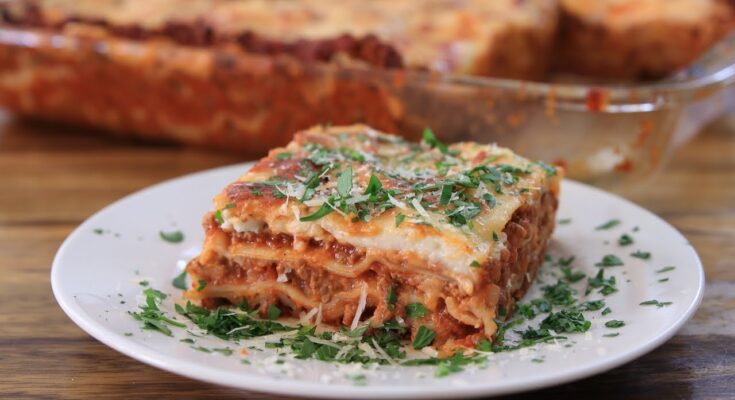Homemade Lasagna Recipe: Lasagna is one of those dishes that brings everyone to the table. It’s warm, cheesy, hearty, and packed with layers of flavor that feel like a big cozy hug. Whether it’s Sunday dinner with family, a gathering with friends, or a meal prep masterpiece for the week, lasagna checks all the boxes. The beauty of this Italian classic lies in its comforting layers—meaty sauce, gooey cheese, and tender pasta that meld together into one glorious bite.
People love lasagna not just for how it tastes but for what it represents: togetherness, tradition, and indulgence. Plus, it’s versatile. You can stick with the traditional beef version or switch it up with veggies, sausage, or even a white sauce. Whether you’re making it for the first time or the fiftieth, lasagna always feels special.
It’s also one of the best “make-ahead” dishes. You can prep it the night before, pop it in the fridge, and bake it fresh the next day. Leftovers? Even better. The flavors deepen and meld, making every bite even more irresistible.
Origin and Popularity Across Cultures
Lasagna originated in Italy, specifically from the region of Emilia-Romagna, the home of the now-iconic Bolognese sauce. Traditionally, Italians layer fresh egg pasta sheets with a rich meat ragu and béchamel sauce. Over the years, as the dish made its way around the globe, it adapted to different tastes and ingredients. In America, lasagna commonly includes ricotta, mozzarella, ground beef, and tomato sauce.
Each culture adds its own spin. Some Middle Eastern variations incorporate eggplant or lamb. In Latin America, you’ll find lasagna with plantains instead of pasta sheets. It’s proof that this dish knows no borders—it’s just that good.
Today, lasagna is a staple in many households, featured on holiday menus and weeknight dinners alike. It’s beloved not just for its flavor but for its ability to feed a crowd, comfort the soul, and deliver consistent deliciousness every single time.
Ingredients You’ll Need for Homemade Lasagna
Essential Ingredients for the Sauce
The sauce is the soul of your lasagna. For a classic meat sauce, here’s what you’ll need:
- Ground beef or a mix of beef and pork (1 pound)
- Onion (1 medium, diced)
- Garlic (3-4 cloves, minced)
- Crushed tomatoes (1 can, 28 oz)
- Tomato paste (2 tablespoons)
- Tomato sauce (1 can, 15 oz)
- Olive oil (2 tablespoons)
- Salt, pepper, and Italian seasoning (to taste)
- Sugar (1 teaspoon, optional, to balance acidity)
- Red pepper flakes (optional, for a spicy kick)
- Fresh basil or parsley (chopped, for added freshness)
Simmer the sauce low and slow for at least 30 minutes to develop that rich, deep flavor. You can also add a splash of red wine to elevate the taste or some grated parmesan for a cheesy twist.
Cheese Layer Ingredients
The creamy cheese filling is what sets this lasagna apart. Here’s what you’ll need:
- Ricotta cheese (15 oz)
- Shredded mozzarella (2 cups)
- Grated Parmesan cheese (1 cup)
- Egg (1, to bind the filling)
- Salt, pepper, and Italian herbs (to taste)
Some like to add chopped spinach or fresh herbs to the cheese mixture for an extra burst of flavor. You can also substitute cottage cheese for ricotta if you’re looking for a lighter or more budget-friendly option.
Pasta and Additional Seasonings
- Lasagna noodles (9-12, depending on your pan size)
- You can use regular, oven-ready, or even fresh pasta sheets.
- Butter or olive oil (to grease the pan)
- Extra mozzarella or parmesan (for topping)
Boil the noodles if you’re using traditional ones. Be sure to salt your pasta water generously—it’s your only chance to season the noodles. Also, slightly undercook them since they’ll continue cooking in the oven.
Ready to put it all together? Let’s move into the action.
Step-by-Step Guide to Making Lasagna
Step 1: Preparing the Meat Sauce
Start by heating olive oil in a large skillet or saucepan over medium heat. Add diced onions and sauté until soft and translucent. Toss in the minced garlic and cook until fragrant—about 30 seconds.
Add your ground meat to the pan, breaking it up with a wooden spoon. Cook until browned and fully cooked through, draining off any excess fat.
Now it’s time to layer in the flavor: stir in tomato paste, crushed tomatoes, and tomato sauce. Season with salt, pepper, Italian seasoning, and a pinch of sugar. Add a splash of red wine if you’re feeling fancy.
Let this simmer uncovered for at least 30-40 minutes, stirring occasionally. The sauce should thicken and the flavors should meld beautifully. Taste and adjust the seasoning as needed. Once done, set aside to cool slightly before layering.
Step 2: Cooking the Lasagna Noodles
If you’re using traditional lasagna noodles, bring a large pot of salted water to a boil. Add the noodles and cook them for 8–10 minutes or until they’re al dente. Don’t overcook, as they’ll continue baking in the oven and might become too soft or fall apart.
Once cooked, drain them immediately and lay them flat on parchment paper or lightly oiled baking sheets to prevent sticking. You can also drizzle a bit of olive oil on them for extra protection against clumping. If you’re using oven-ready noodles, you can skip this step, but consider adding a bit more sauce to your layers since these noodles absorb more moisture.
If you want to go gourmet, try using fresh pasta sheets. These only need a few seconds of boiling, and they deliver a soft, luxurious texture that melts into the layers of cheese and sauce.
Remember, the noodles act as both structure and flavor carriers—treat them with care and they’ll hold your lasagna together perfectly.
Step 3: Mixing the Cheese Filling
Now it’s time to create that creamy, cheesy middle layer that makes lasagna so irresistible. In a large mixing bowl, combine your ricotta cheese, beaten egg, a cup of shredded mozzarella, half a cup of grated Parmesan, and your choice of herbs like parsley, basil, or oregano. Season with salt and pepper.
Mix everything together until it forms a smooth, uniform mixture. The egg is essential—it binds the filling and gives it a rich, custardy texture when baked. If you want to lighten it up, swap ricotta for cottage cheese or add some sautéed spinach for a touch of green and a burst of nutrition.
Some lasagna lovers add a touch of nutmeg to the cheese filling—a subtle nod to traditional Italian béchamel. It gives the dish a slightly warm, earthy flavor that pairs beautifully with the richness of the cheese.
Once your cheese filling is ready, set it aside. You’ll use it to create one of the most important layers of your lasagna.
Step 4: Layering the Lasagna
Now comes the fun part—assembling your masterpiece. Preheat your oven to 375°F (190°C). Lightly grease a 9×13 inch baking dish with butter or olive oil.
Here’s the layering process:
- Start with Sauce – Spread a thin layer of meat sauce on the bottom of the pan. This prevents the noodles from sticking and adds flavor from the ground up.
- Add Noodles – Lay 3–4 noodles over the sauce, slightly overlapping.
- Add Cheese Layer – Spoon and spread about ⅓ of the ricotta cheese mixture over the noodles.
- Add Sauce Again – Spoon a generous layer of meat sauce over the cheese.
- Add Mozzarella – Sprinkle with shredded mozzarella and a touch of parmesan.
- Repeat – Keep layering: noodles, ricotta, sauce, mozzarella. Usually, you’ll get three full layers.
- Top Layer – Finish with noodles, remaining sauce, and a hearty sprinkle of mozzarella and parmesan.
The goal is to create layers that are even and full, so every bite includes a bit of everything. If your pan is deep enough, go for four layers—why not?
Cover the dish with foil (spray the underside with non-stick spray to avoid cheese sticking) and prepare for the magic to happen in the oven.
Step 5: Baking the Lasagna
Place the foil-covered lasagna in the preheated oven and bake for 25 minutes. After that, remove the foil and continue baking for another 20–25 minutes, or until the top is golden and bubbling. If you want that irresistibly crispy top layer, broil it for 2–3 minutes at the end—just keep a close eye so it doesn’t burn.
Once baked, resist the urge to cut immediately. Let the lasagna rest for at least 15–20 minutes. This helps everything set so your slices stay together and look picture-perfect on the plate.
And there you have it—lasagna that’s layered with love and baked to perfection. But we’re not done just yet. Let’s go over some tips to ensure you’re always making lasagna like a pro.
Pro Tips to Make Your Lasagna Perfect
Tips for Layering Like a Pro
Mastering the art of layering is what separates a good lasagna from a legendary one. While it might seem straightforward, there are a few tricks that can help you build layers that are balanced, flavorful, and structurally sound.
First, always begin with a thin layer of sauce on the bottom of your pan. This not only prevents sticking but also ensures the noodles stay moist and cook evenly. Think of the sauce as the foundation—it needs to be sturdy and flavorful. Each layer should have a clear order: noodles, cheese filling, meat sauce, shredded cheese. Repeat until you reach the top, then finish with a generous topping of sauce and cheese.
Try not to overload any one layer. It’s tempting to pile on the cheese or sauce, but too much can make your lasagna slide apart or get soggy. Balance is key—each component should shine without overpowering the others.
One underrated tip? Alternate the direction of your noodles with each layer (horizontal, then vertical). This crisscross method gives your lasagna extra strength and helps hold everything together.
Lastly, don’t forget to press down gently after each layer to eliminate air pockets and keep the structure tight. A compact lasagna bakes more evenly and slices beautifully.
Avoiding Common Mistakes
Even seasoned cooks can run into issues when making lasagna. Here are a few common mistakes to avoid:
- Using too much sauce: Over-saucing can lead to a soupy lasagna. Use just enough to coat each layer generously without drowning it.
- Not draining noodles properly: Wet noodles add excess moisture. Make sure they’re drained and dried on parchment paper or towels.
- Skipping the rest time: This is crucial! Letting the lasagna rest allows the cheese to set and the layers to firm up. Slice too early, and you’ll have a mess on your hands.
- Using low-moisture cheese incorrectly: Mozzarella is key, but using only fresh mozzarella can cause sogginess. Blend it with low-moisture mozzarella for the perfect melt and consistency.
- Forgetting seasoning: Each component should be seasoned well. Bland ricotta or under-seasoned sauce will make the whole dish fall flat.
Avoiding these pitfalls can take your lasagna from decent to restaurant-quality in one go.
Serving and Storing Homemade Lasagna
How to Serve it Right
Serving lasagna might seem simple, but doing it the right way elevates the experience. Once your lasagna has rested, use a sharp knife to cut through the layers, then a wide spatula to lift out neat, structured portions. Start with smaller slices—they’re rich and filling, and guests can always come back for seconds.
Garnish with freshly chopped parsley or basil to brighten the flavors and add a pop of color. If you’re hosting, serve it with a side salad (like Caesar or arugula with vinaigrette) and some crusty garlic bread to round out the meal.
For drinks, red wine like Chianti or a bold Zinfandel pairs beautifully with the hearty, cheesy goodness. If you’re avoiding alcohol, try sparkling water with lemon or a tangy Italian soda.
And don’t forget to take a moment to enjoy your creation. You’ve earned it.
Storing and Reheating Leftovers
One of the best things about lasagna is how well it stores. In fact, some say it tastes even better the next day! Here’s how to keep it fresh:
- Refrigerate: Store leftovers in an airtight container or cover the pan tightly with foil. It’ll stay good in the fridge for 4–5 days.
- Freeze: Want to save it longer? Cut into individual portions, wrap each piece in plastic wrap and foil, and freeze. It’ll keep for up to 3 months.
- Reheating: For refrigerated slices, microwave on medium heat for 2–3 minutes or reheat in the oven at 350°F for about 20 minutes. For frozen, let it thaw overnight in the fridge before reheating.
Whether fresh, next-day, or reheated from the freezer, homemade lasagna always delivers the same cozy, comforting flavor. It’s the gift that keeps on giving.
FAQs about Homemade Lasagna Recipe
1. Can I make lasagna ahead of time?
Yes! Homemade lasagna is perfect for meal prep. You can assemble it up to 24 hours in advance and store it in the refrigerator. When ready, bake as directed, adding an extra 10–15 minutes to the cooking time if baking straight from the fridge.
2. How do I store leftover lasagna?
Let the lasagna cool completely, then cover and refrigerate it for up to 4–5 days. For longer storage, wrap individual portions tightly in foil or plastic wrap and freeze for up to 3 months.
3. Can I freeze unbaked lasagna?
Absolutely! Assemble the lasagna, cover it tightly with foil, and freeze. When you’re ready to enjoy it, bake directly from frozen—just extend the baking time by about 30–45 minutes.
4. What’s the best cheese for lasagna?
Mozzarella is the classic go-to for melty goodness. Ricotta adds creaminess, and a sprinkle of Parmesan on top brings a savory finish. You can also mix in provolone or fontina for extra flavor.
5. How many layers should lasagna have?
A traditional lasagna typically has 3 to 4 layers of noodles and filling. However, more layers can be added based on the depth of your baking dish.
6. Can I use no-boil lasagna noodles?
Yes, no-boil noodles save time and work great. Just ensure there’s enough sauce and moisture in your lasagna so the noodles cook properly during baking.
7. How long should lasagna rest before serving?
Let it rest for at least 10–15 minutes after baking. This allows the layers to set and makes slicing much easier.
8. What’s the best meat for lasagna?
A mix of ground beef and Italian sausage is a flavorful combo. You can also use ground turkey or keep it vegetarian by using sautéed vegetables and a hearty tomato sauce.
9. Can I make lasagna gluten-free?
Yes! Use gluten-free lasagna noodles and double-check that all your sauces and seasonings are gluten-free as well.
10. Why is my lasagna watery?
Too much sauce or wet ingredients like ricotta can lead to watery lasagna. Make sure to drain excess moisture from cooked vegetables and simmer sauces to thicken them before layering.
Conclusion
The best part? Lasagna allows for creativity. You can swap in vegetables, use a different kind of meat, or even go entirely meatless with marinara and roasted veggies. It can be as simple or as gourmet as you want. The process is meditative, almost like assembling a delicious puzzle—layer by layer, aroma by aroma, until you have a bubbling masterpiece.
Take your time with it. Let the sauce simmer, let the noodles rest, and most importantly, let yourself enjoy the journey of making something from scratch. There’s nothing quite like pulling a hot tray of lasagna out of the oven, knowing you crafted every bite with your own hands.
So grab your apron, gather your ingredients, and start layering some love. Homemade lasagna is more than a meal—it’s a memory in the making.



